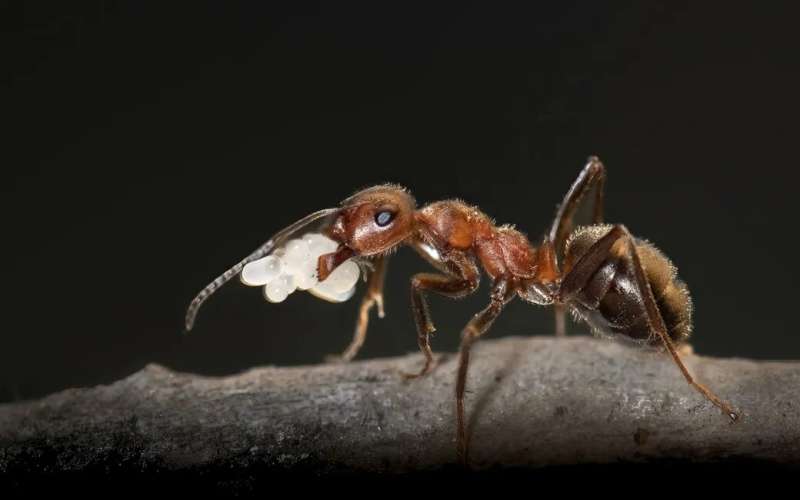Researchers discover rapid and predictable genome evolution across three hybrid ant populations

Over the past ten years, the DNA sequencing revolution has revealed that mating between two different species, i.e., hybridization, once considered rare, is actually widespread across the tree of life. This came as a surprise—hybridization was considered mostly detrimental since offspring are not always viable and can be infertile, like mules. However, many studies showed that hybridization could have beneficial consequences and help populations adapt to new environments.
For instance, in humans, Tibetan populations are adapted to low oxygen concentrations found under high altitudes thanks to genetic material acquired through hybridization, 50,000 years ago, between modern and archaic humans, now extinct populations (such as Neanderthals). This year, the Nobel Prize in Physiology or Medicine was awarded to Svante Pääbo (Max Planck Institute) for his work on human evolution, including gene exchange between modern and archaic humans.
Understanding the consequences of hybridization, i.e., mating between two different species, giving hybrid offspring, is important because it is a widespread phenomenon in nature. By transferring genetic material between species, it can also help populations adapt to new challenging environments, such as warming climate. One key aspect of hybridization is predictability, which is also an important research question: if we could redo the same hybridization event several times, how often would we get similar results?
Populations evolve both quickly and predictably because of natural selection
Researchers at the University of Helsinki took advantage of distinct hybrid wood ant populations identified in Southern Finland to study whether hybridization was predictable. They found that after multiple hybridization events between two wood ant species, distinct hybrid populations evolved independently in the same direction. They are nowadays highly similar to one another in terms of genetic composition, suggesting that the outcome of hybridization is predictable. Researchers also determined that hybridization occurred less than 50 ant generations ago, approximately 125 years ago, making it a fairly rapid case of evolution in the wild.
"Since hybridization is also frequent in many other species than ants, our results could help understand its consequences more generally. On the long term, our work would help better apprehend the impact of hybridization in the wild and assess whether it could help species cope with changing environments," says Docent Jonna Kulmuni, from the Faculty of Biological and Environmental Sciences, University of Helsinki. She has been leading ant research for 15 years.
A small step or giant leap in knowledge?
"A bit of both. Finnish wood ants give the opportunity to observe multiple, very recent hybridization events, and the amount of predictability we found despite this recency is remarkably high, which is quite novel," explains researcher Pierre Nouhaud, from the Faculty of Biological and Environmental Sciences, University of Helsinki.
"In the meantime, our study also confirms previous results obtained in a handful of species, including humans, suggesting the patterns we see in wood ants are quite general."
DNA contains information about the evolutionary history of populations
For this study the research group collected hybrid individuals in Finnish forests in Southern Finland, close to the Tvärminne Zoological Station. DNA accumulates mutations as it is transmitted from parents to offspring, as such it contains information about the evolutionary history of populations.
Accessing this history required researchers to reconstruct the first reference genome for red wood ants. Researchers then sequenced and analyzed hybrid genomes using supercomputers from the Finnish IT center for science (CSC). Some analyses were carried out in collaboration with scientists from Scotland and Portugal.
Reconstructing past evolutionary histories using computer simulations
"On an evolutionary timescale, we are dealing with recent events, less than 50 ant generations, which had very little time to leave footprints in DNA sequences. This means it can be hard to distinguish between competing hypotheses. In our study we performed computer simulations considering different evolutionary scenarios to take this uncertainty into account and ensure our results are robust," says Nouhaud.
The paper is published in the journal PLOS Biology.
Next the ant research group will monitor the genetic composition of hybrid populations over multiple years to find evidence for adaptation and test whether hybrids can combine temperature ranges from both species, which might help wood ants deal with warming climate. According to Nouhaud this could be quite important because wood ants are key species of boreal forests: they provide food for many species, contribute to nutrient cycling, hunt many other insects, among other things. Without them, Finnish forests would certainly look quite different.
More information: Pierre Nouhaud et al, Rapid and predictable genome evolution across three hybrid ant populations, PLOS Biology (2022). DOI: 10.1371/journal.pbio.3001914
Journal information: PLoS Biology
Provided by University of Helsinki


















